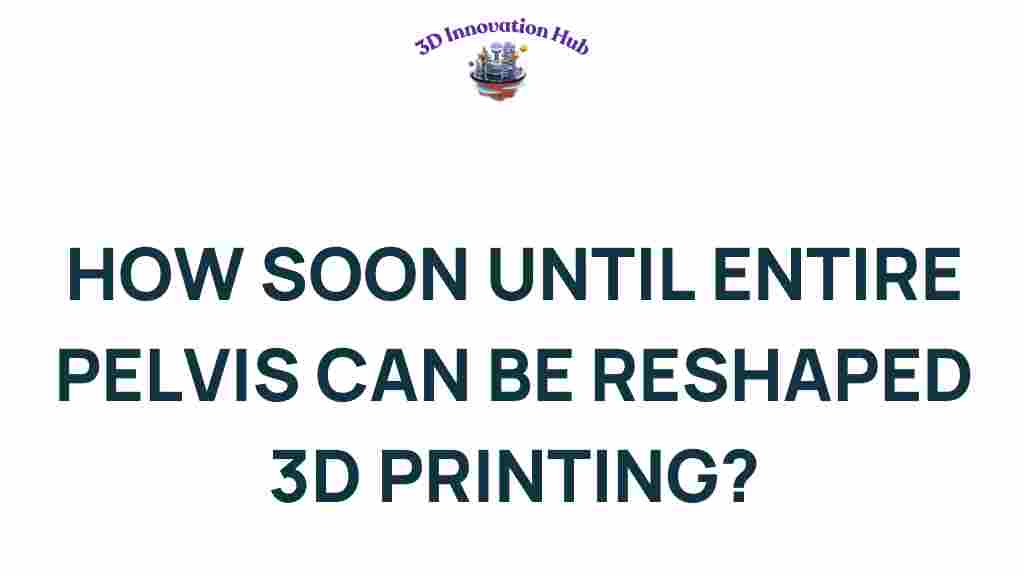The Future of Medicine: How Soon Can 3D Printing Reshape Pelvises?
In the rapidly evolving landscape of healthcare technology, few innovations hold as much promise as 3D printing. This cutting-edge technology is set to revolutionize various aspects of medicine, particularly in pelvis reshaping. As medical professionals continually seek ways to enhance patient care, the integration of 3D printing into surgical advancements is paving the way for groundbreaking solutions in orthopedic surgery and personalized medicine. In this article, we will explore the future of medicine concerning 3D printing and its potential to reshape pelvises, diving into the mechanics of the process, its benefits, challenges, and future prospects.
The Evolution of 3D Printing in Medicine
3D printing, or additive manufacturing, has transformed industries from manufacturing to aerospace. In medicine, its impact is profound, allowing for the creation of patient-specific models and devices. The technology utilizes various materials, including plastics, metals, and even biological materials for bioprinting, which is crucial for regenerative medicine.
With the advent of 3D printing, orthopedic surgery has witnessed remarkable advancements. Surgeons can now create precise replicas of a patient’s anatomy, leading to improved surgical outcomes. For pelvis reshaping, this is especially significant, as pelvic deformities can affect mobility and quality of life.
Understanding Pelvis Reshaping
The pelvis is a critical structure in the human body, supporting the spine and protecting internal organs. However, congenital deformities, trauma, or degenerative diseases can necessitate pelvis reshaping to restore function and alleviate pain. Traditional surgical methods often involve invasive procedures that come with risks of complications and extended recovery times.
With the integration of 3D printing, orthopedic surgeons can now craft customized implants and surgical guides tailored to each patient’s unique anatomy. This shift towards personalized medicine enhances surgical precision and minimizes recovery time.
Step-by-Step Process of 3D Printing in Pelvic Surgery
The process of pelvis reshaping through 3D printing involves several key steps:
- Patient Assessment: The journey begins with a thorough evaluation of the patient’s condition, including imaging studies such as CT or MRI scans.
- 3D Modeling: Advanced software is utilized to create a 3D model of the pelvis based on the imaging data. This model serves as the foundation for the surgical plan.
- Printing the Surgical Guide: Using 3D printing, a surgical guide is produced. This guide is designed to assist surgeons in accurately reshaping the pelvis during surgery.
- Implant Creation: If necessary, patient-specific implants can also be printed, ensuring an exact fit that promotes better integration with the surrounding bone.
- Surgery: During the procedure, the surgeon uses the printed guide to perform precise cuts and placements, leading to improved outcomes.
- Post-Operative Care: Following surgery, the recovery process is often expedited due to the less invasive nature of the procedure.
Benefits of 3D Printing in Pelvis Reshaping
The benefits of utilizing 3D printing in pelvis reshaping are numerous:
- Increased Precision: 3D-printed guides allow for more accurate surgical interventions, reducing the risk of errors.
- Enhanced Customization: Each implant and guide is tailored to the individual patient, promoting better outcomes.
- Reduced Surgical Time: Surgeons can operate more efficiently with the aid of precise guides, leading to shorter procedures.
- Lower Risk of Complications: Minimally invasive techniques reduce the likelihood of post-operative complications.
- Faster Recovery: Patients often experience quicker recovery times, getting back to their daily activities sooner.
Challenges and Considerations
Despite the promising future of 3D printing in medicine, there are challenges to consider:
- Regulatory Hurdles: The FDA and other regulatory bodies must establish guidelines for the use of 3D-printed medical devices.
- Material Limitations: Not all materials are suitable for every application. Research is ongoing to find biocompatible materials.
- Cost Factors: While costs are decreasing, 3D printing technology can still be expensive to implement and maintain.
- Training Needs: Surgeons and medical personnel require training to effectively use this technology.
Future Prospects of 3D Printing in Pelvic Surgery
The future of 3D printing in pelvis reshaping looks bright, with ongoing research and development aimed at overcoming current challenges. Some exciting prospects include:
- Integration with AI: Artificial intelligence could enhance the design process, making models even more precise.
- Advanced Bioprinting: The potential for bioprinting living tissues could revolutionize the way we approach orthopedic surgery.
- Telemedicine and Remote Printing: As telemedicine evolves, remote printing capabilities could allow for quicker interventions.
- Broader Applications: Beyond pelvis reshaping, 3D printing could be applied to other orthopedic procedures and even soft tissue surgeries.
Troubleshooting Tips for 3D Printing in Healthcare
For healthcare professionals looking to implement 3D printing, consider the following troubleshooting tips:
- Ensure Accurate Scanning: High-quality imaging is crucial for creating accurate 3D models.
- Material Testing: Always test materials for biocompatibility and strength before clinical use.
- Regular Maintenance: Keep 3D printers well-maintained to avoid technical issues during critical times.
- Stay Updated: Keep abreast of the latest research and advancements in the field of 3D printing.
Conclusion
The integration of 3D printing into pelvis reshaping represents a significant leap forward in medical innovations. As surgeons gain access to personalized solutions that enhance precision and reduce recovery times, the overall quality of patient care is set to improve dramatically. While challenges remain, the potential benefits of 3D printing in orthopedic surgery are too significant to ignore.
As we look to the future, the possibilities of 3D printing in healthcare technology are immense. Innovations like bioprinting and personalized medicine will continue to shape the landscape of medicine, offering hope to patients worldwide. For more information on how 3D printing is changing the medical field, visit this resource.
In conclusion, the question is not if 3D printing will reshape pelvises, but when. As the technology matures, we can expect to see it become a commonplace tool in orthopedic surgeries, transforming the way we approach patient care.
This article is in the category and created by 3D Innovation Hub Team
